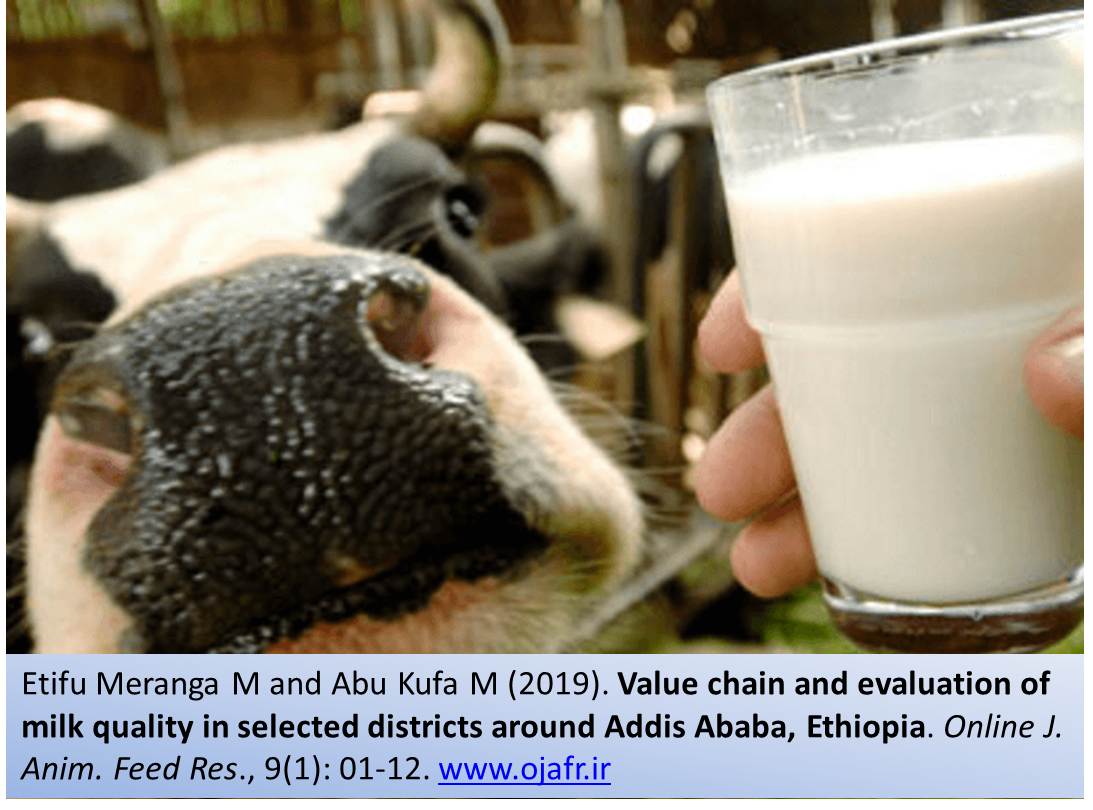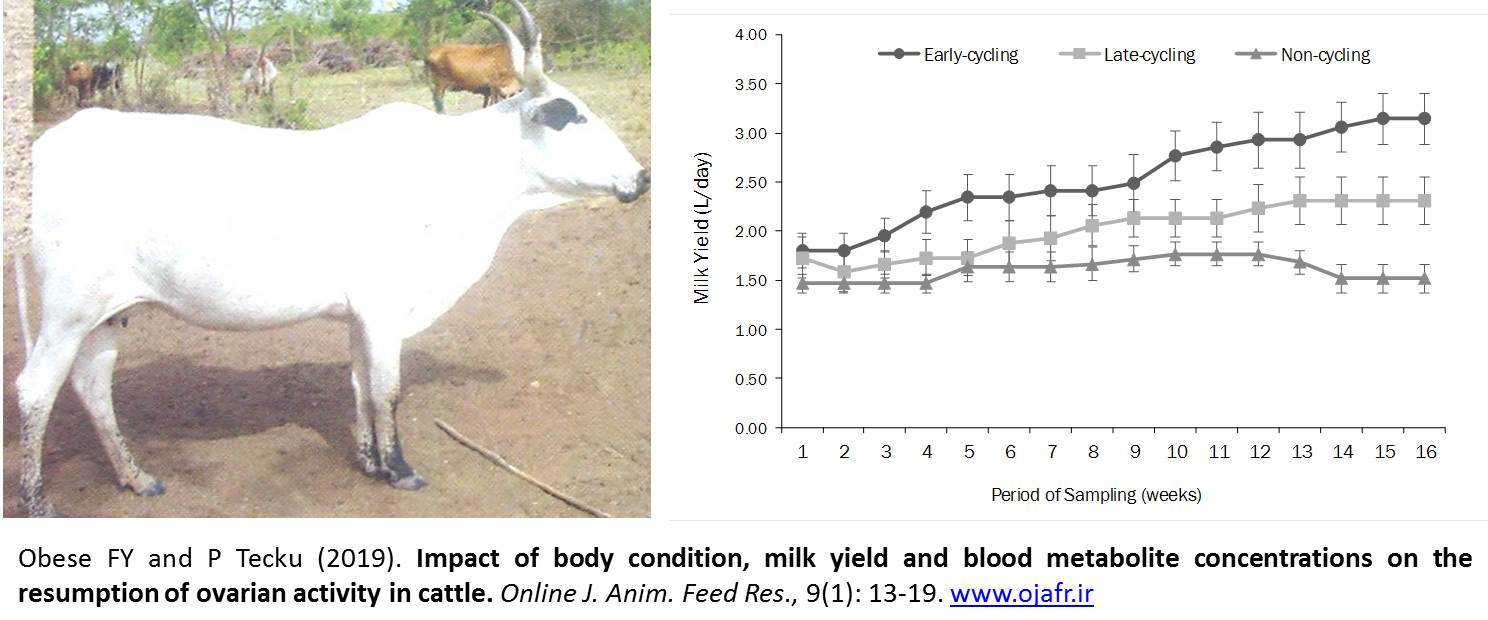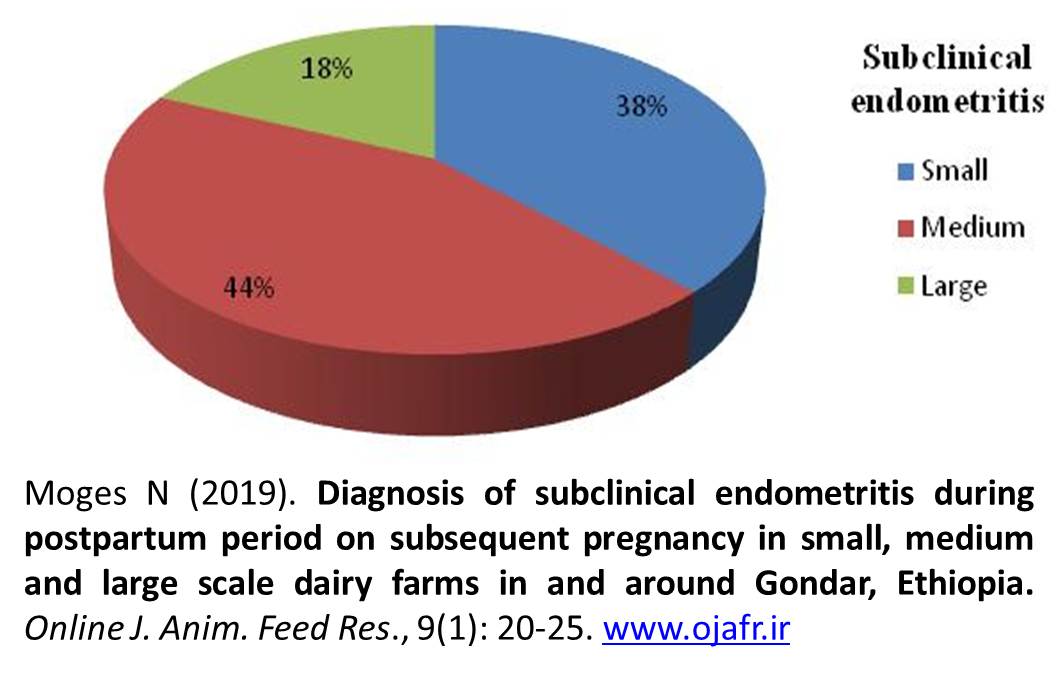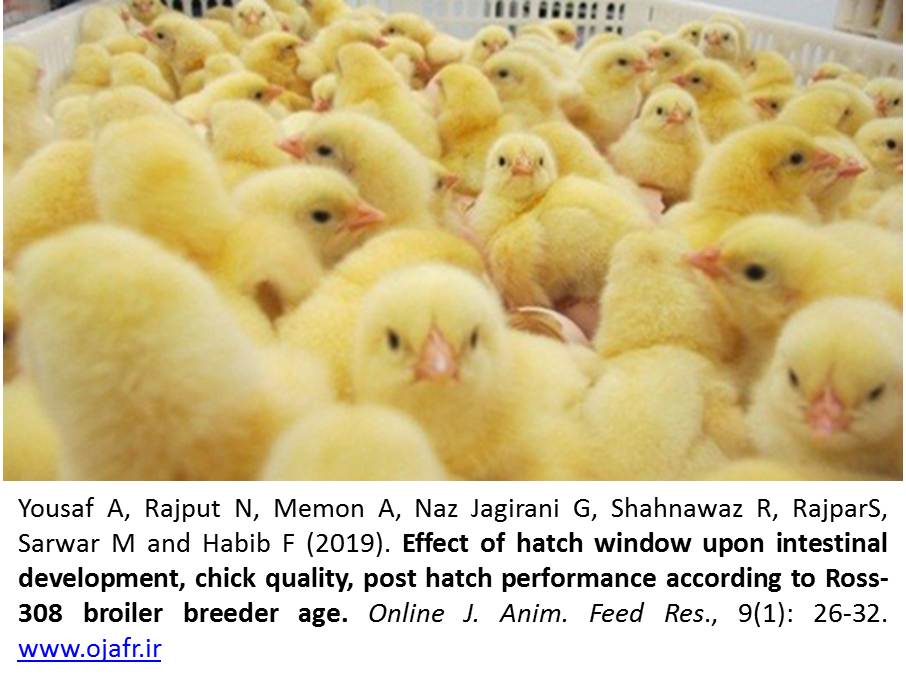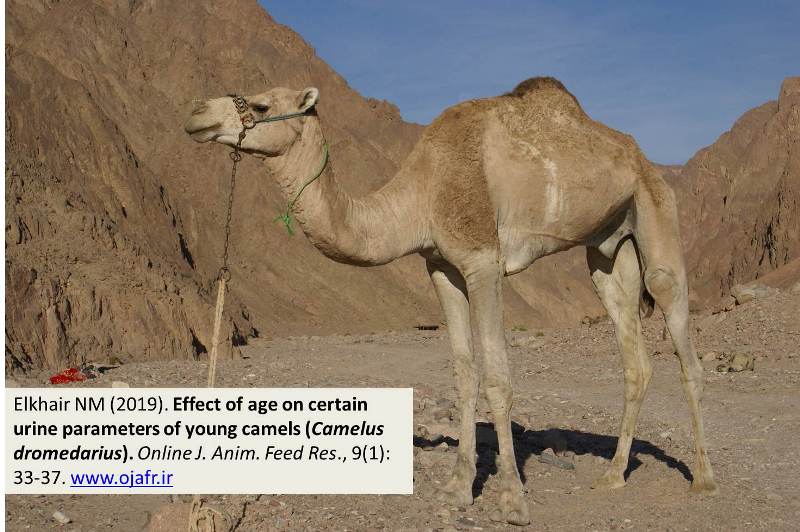Previous issue | Next issue | Archive
Volume 9 (1); January 25, 2019 [Booklet]
Value chain and evaluation of milk quality in selected districts around Addis Ababa, Ethiopia.
Etifu Meranga M and Abu Kufa M.
Online J. Anim. Feed Res., 9(1): 01-12, 2019; pii: S222877011900001-9
Abstract
Evaluation of milk value chain and the quality of milk were assessed in selected districts of surrounding Addis Ababa from September 2016 to April 2017. A total of 180 randomly selected market-oriented smallholder dairy farmers were involved in a cross-sectional study that was carried out by way of a questionnaire survey, rapid market appraisal, farm inspection and group discussion. The overall mean family size of respondents in this study was 5.63±1.926 persons with average livestock holding per household of 23.93±11.755 animals. Cattle were the predominant species representing 84.3% of the total TLU. The average number of lactating cows owned by the respondent farmers was 1.76±0.920 local and 2.79±3.445 crossbred animals. Average daily milk yield of crossbred and local milking cows were 9.11±2.902 and 1.889±0.6707 liters respectively. Overall mean lactation lengths of crossbred and local milking cows were 9.7±0.46 and 6.26±0.6624 months. Sixty milk samples were collected and microbiological and physicochemical analyses were carried out. The overall mean chemical compositions of milk for fat, protein and solids not fat (%) were 3.5693±0.10892, 2.9646 ± 0.04621 and 6.9632±0.12175 in bulk Tank milk samples. The overall mean microbiological count of log (TBC cfu/ml), log (CC cfu/ml) and log (SCC/ml) of raw milk was 8.2285±0.10041, 3.3363±0.10010 and 5.1622±0.07382, respectively. The proportion of raw milk used for household consumption was relatively small (5%). The major part (86%) of milk produced by smallholders is destined to market. The main outlets for raw milk identified were cooperatives (55.6%), processors (20.0%), vendor (20.0%), directly to consumer (2.8%) and hotels/ restaurants (1.7%). Price variations (cited by 87% of the respondents), lack of fair market (72.2%), lack of demand during fasting (49.4%), lack of preserving facilities, and absence of quality-based payment and no/less say in deciding milk price by producers were the major problems of raw milk marketing.
Keywords: Coliform, Milk, Physicochemical, Total bacteria, Value-chain.
[Full text-PDF]
Impact of body condition, milk yield and blood metabolite concentrations on the resumption of ovarian activity in cattle.
Obese FY and P Tecku.
Online J. Anim. Feed Res., 9(1): 13-19, 2019; pii: S222877011900002-9
Abstract
Body condition of cows, level of milk production and concentrations of blood metabolites can influence the resumption of ovarian activity in cattle. This study investigated the relationships among body weight (BW), body condition score (BCS), milk yield, blood metabolite [Glucose, total protein, albumin, globulin, urea, triglyceride, non-esterified fatty acids (NEFA) and Beta-hydroxybutyrate (BHB)] concentrations and resumption of postpartum ovarian cyclicity in 20 Sanga and 20 Friesian × Sanga cows. Cows were classified as having resumed ovarian activity when they had plasma progesterone concentration of ≥ 1 ng/mL. Based on the resumption of ovarian activity, cows were also classified into three ovarian cyclicity groups namely; early resumption of ovarian cyclicity (≤ 56 days postpartum), late resumption of ovarian cyclicity (57-112 days postpartum) and non-resumption of ovarian cyclicity (by 112 days postpartum). BW, BCS and milk yield did not affect (P< 0.05) cycling status in Sanga cows. Friesian × Sanga that resumed ovarian cyclicity early (2.54 L/day) or late (2.01 L/day) had higher milk yield (P < 0.05) than their counterparts that did not resumed ovarian cyclicity during the period of study (1.61 L/day). However, BW and BCS were similar (P > 0.05) in the three ovarian cyclicity groups in the Friesian × Sanga cows. Sanga cows that resumed ovarian cyclicity early had lower total protein concentration than those that resumed ovarian cyclicity late (76.8 versus 89.3 g/L; P < 0.05). Globulin concentration was also lower (P < 0.05) in cows that resumed cyclicity early (42.6 g/L) than late (54.2 g/L) and non-cycling (49.7g/L) Sanga cows. There were significant (P < 0.05) positive and negative correlations among some of the plasma metabolites determined. In conclusion, earlier resumption of ovarian cyclicity was associated with higher milk yield in Friesian × Sanga cows and lower concentrations of total protein and globulin in Sanga cows. Improved feeding and management strategies are recommended for the achievement of reproductive success in cows.
Keywords: Body Weight, Cow, Nutritional Status, Ovulation, Relationships, Supplement
[Full text-PDF]
Diagnosis of subclinical endometritis during postpartum period on subsequent pregnancy in small, medium and large scale dairy farms in and around Gondar, Ethiopia.
Moges N.
Online J. Anim. Feed Res., 9(1): 20-25, 2019; pii: S222877011900003-9
Abstract
During the study period 147 apparently healthy 3rd trimester pregnant cows were selected in smallholder, medium and large scale dairy farms in and around Gondar, North Western Ethiopia from January 2015 to September 2017. After calving, endometrial samples were collected from the uterus of apparently normal cows by using uterine lavage technique on postpartum dairy cows from 40-60 days. Collected samples were centrifuged and a drop of sediment was streaked onto a clean microscopic slide and stained with giemsa. The percentage of polymorphonuclear cells (neutrophils) was calculated. It was found that increase in the number of neutrophils correlated with decrease in pregnancy. In conclusion, subclinical endometritis diagnosed by endometrial cytology was associated with reduced rate of pregnancy.
Keywords: Subclinical Endometritis, Endometrial Cytology, Pregnancy, Neutrophiles
[Full text-PDF]
Effect of hatch window upon intestinal development, chick quality, post hatch performance according to Ross-308 broiler breeder age.
Yousaf A, Rajput N, Memon A, Naz Jagirani G, Shahnawaz R, RajparS, Sarwar M and Habib F.
Online J. Anim. Feed Res., 9(1): 26-32, 2019; pii: S222877011800004-9
Abstract
This study was carried out to find out the effects of breeder age on incubation results, intestinal development during hatch window, chick quality and first week broiler performance. A total of 259280 eggs were obtained from commercial Ross-308 broiler breeder flocks at 32 and 52 weeks old, which were equally divided on the basis of breeder age in two groups, group A (young 32 weeks) and group B (old 52 weeks age).These 32 and 52 weeks old flocks, 30% and 7.0% were hatched 24h before pull time and 50% and 60% were hatched 12h before pull time, respectively. Hatchability of fertile eggs and hatchability of total eggs were found higher in 32 weeks old flock than the other. The chick hatch weight was determined as 39.5g and 42.1g in 32 and 52 weeks old flocks, respectively. Chick weight/initial egg weight rate was found to be higher as 67.3% in the 32 weeks old flocks. On hatching day, chick length was also higher in 52 weeks old flock. Relative yolk-free chick weight was higher in 32 weeks old (86.0%) flock than the other (83.0%). Intestine weight rate was higher as 5.24% in chicks from 32 weeks old than the other (4.96%). At one week of age, the body weights and weight gains were 167.5g and 162.7g, and 128g and 120.6g in 32 and 52 weeks old flocks, respectively. Higher mortality ratio as 1.9% was observed in 52 weeks old flock. In conclusion, intestinal development during hatch window, incubation parameters, chick quality and first week broiler performance is affected by breeder age.
Keywords: Incubation duration, Intestinal development, Hatch window, Post-hatch performance, Ross-308 broiler breeder
[Full text-PDF]
Effect of age on certain urine parameters of young camels (Camelus dromedarius).
Elkhair NM.
Online J. Anim. Feed Res., 9(1): 33-37, 2019; pii: S222877011800005-9
Abstract
The objective of this study was to identify reference values for certain urine parameters in relation to the age in young dromedary camels. Twenty one healthy young female camels (age <3-5 months) of Arabi local breed were divided into three groups (≤ 3 m: n=6, 3-4 m: n=8 and 4-5 m: n=7). Jugular venous blood samples were collected and used to determine electrolytes and creatinine concentration, whereas the urine samples were used for the determination of urine pH, urine osmolality, and for the calculation of fractional excretion of electrolytes. The mean value of urine pH was 7.9±0.5 (reference range: 7.2-8.8 and the percentile range: 7.3-8.2) and the urine osmolality in young camels was 978.9±468 (reference range 235-1819 mOsmol/kg) for all age groups. Fractional excretion of Na+ (FE Na+%) showed lower mean values compared to the fractional excretion of K+ and Cl- . The age had a significant (P < 0.05) effect only on urine osmolality in camels of 4-5 months. The identified reference values of certain urine parameters can be used for the clinical diagnosis of renal diseases in growing animals. The data could be utilised for the clinical monitoring of the physiological and pathological status of animals fed strong electrolytes such as Na+, K+ and Cl-.
Keywords: Age, Dromedary camels, Reference values, Urine parameters
[Full text-PDF]
The influence of feed form on broiler production and gastrointestinal tract development.
Kuleile N and Molapo S.
Online J. Anim. Feed Res., 9(1): 38-43, 2019; pii: S222877011800006-9
Abstract
A completely randomized design experiment was conducted to assess the influence of feed form on broiler production and gastrointestinal tract development. A total of (n= 315) 16 days-old Ross 308 chicks were randomly assigned to three dietary treatments (mash, crumbles and pellets) with three replicates. Weekly data indicated that birds on pellet and crumble diets had a significant (P < 0.05) improvement on a number of production parameters than birds fed diet in a mash form. Data for average values for the whole experimental period demonstrated that the dietary treatments had significant effect on feed intake (0.001), body weight (P= 0.013), performance index (P=0.040), abdominal fat weight (P= 0.010) and carcass weight. (P= 0.001). However, feed conversion ratio and carcass yield did not show significant (P > 0.05) response to dietary treatments. Contrary to weekly data the averages for the whole experimental period data was dominated by birds on crumble diet with the highest feed intake, body weight, abdominal fat weight and carcass weight. Gastrointestinal tract development results indicated that dietary treatment had a significant effect on intestinal length (P= 0.015) whereby birds that consumed diet in a mash form had superior intestinal length. The intestinal and gizzard weight parameters were not significantly (P > 0.05) influenced by the dietary treatment. The results of the current study proved that the crumble form of a diet is the most suitable for optimum broiler production during growing and finishing stages while diet in a mash form is suitable for optimum development of gastrointestinal tract.
Keywords: carcass yield, Crumble, Feed form, GIT development, Mash, Pellets
[Full text-PDF]
Previous issue | Next issue | Archive![]()
| < Prev | Next > |
|---|

